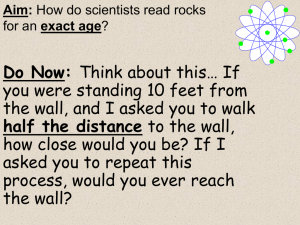Absolute-Age-Dating
advertisement
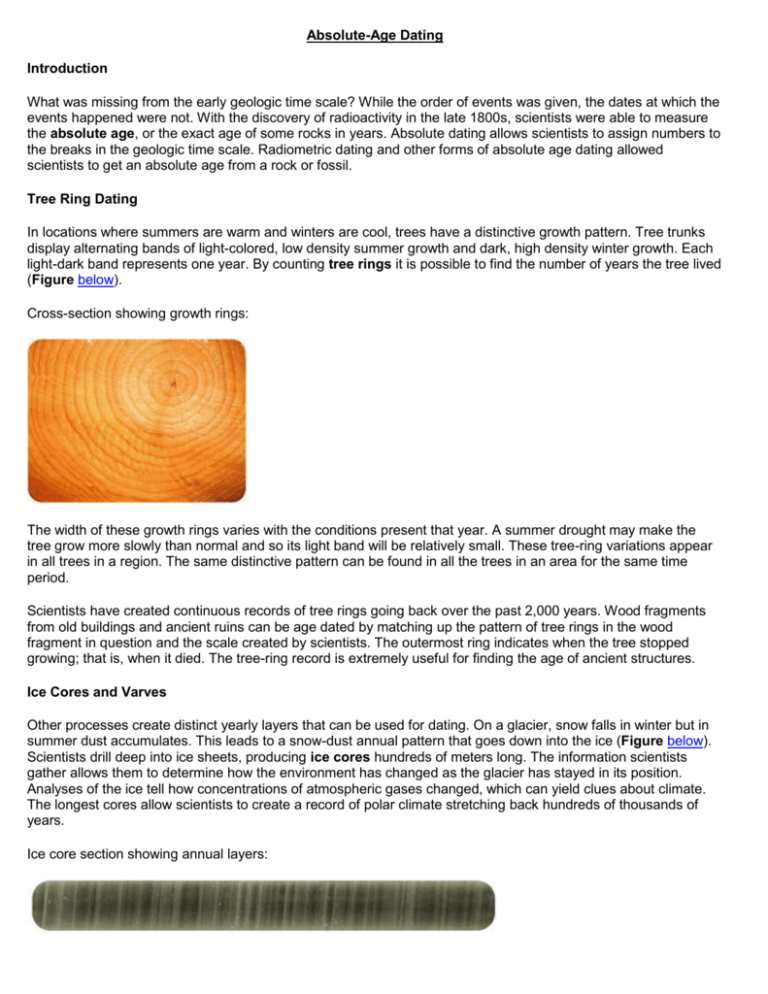
Absolute-Age Dating Introduction What was missing from the early geologic time scale? While the order of events was given, the dates at which the events happened were not. With the discovery of radioactivity in the late 1800s, scientists were able to measure the absolute age, or the exact age of some rocks in years. Absolute dating allows scientists to assign numbers to the breaks in the geologic time scale. Radiometric dating and other forms of absolute age dating allowed scientists to get an absolute age from a rock or fossil. Tree Ring Dating In locations where summers are warm and winters are cool, trees have a distinctive growth pattern. Tree trunks display alternating bands of light-colored, low density summer growth and dark, high density winter growth. Each light-dark band represents one year. By counting tree rings it is possible to find the number of years the tree lived (Figure below). Cross-section showing growth rings: The width of these growth rings varies with the conditions present that year. A summer drought may make the tree grow more slowly than normal and so its light band will be relatively small. These tree-ring variations appear in all trees in a region. The same distinctive pattern can be found in all the trees in an area for the same time period. Scientists have created continuous records of tree rings going back over the past 2,000 years. Wood fragments from old buildings and ancient ruins can be age dated by matching up the pattern of tree rings in the wood fragment in question and the scale created by scientists. The outermost ring indicates when the tree stopped growing; that is, when it died. The tree-ring record is extremely useful for finding the age of ancient structures. Ice Cores and Varves Other processes create distinct yearly layers that can be used for dating. On a glacier, snow falls in winter but in summer dust accumulates. This leads to a snow-dust annual pattern that goes down into the ice (Figure below). Scientists drill deep into ice sheets, producing ice cores hundreds of meters long. The information scientists gather allows them to determine how the environment has changed as the glacier has stayed in its position. Analyses of the ice tell how concentrations of atmospheric gases changed, which can yield clues about climate. The longest cores allow scientists to create a record of polar climate stretching back hundreds of thousands of years. Ice core section showing annual layers: Lake sediments, especially in lakes that are located at the end of glaciers, also have an annual pattern. In the summer, the glacier melts rapidly, producing a thick deposit of sediment. These alternate with thin, clay-rich layers deposited in the winter. The resulting layers, called varves, give scientists clues about past climate conditions (Figure below). A warm summer might result in a very thick sediment layer while a cooler summer might yield a thinner layer. Ancient varve sediments in a rock outcrop: Age of Earth During the 18th and 19th centuries, geologists tried to estimate the age of Earth with indirect techniques. What methods can you think of for doing this? One example is that by measuring how much sediment a stream deposited in a year, a geologist might try to determine how long it took for a stream to deposit an ancient sediment layer. Not surprisingly, these methods resulted in wildly different estimates. A relatively good estimate was produced by the British geologist Charles Lyell, who thought that 240 million years had passed since the appearance of the first animals with shells. Today scientists know that this event occurred about 530 million years ago. In 1892, William Thomson (later known as Lord Kelvin) calculated that the Earth was 100 million years old He did this systematically assuming that the planet started off as a molten ball and calculating the time it would take for it to cool to its current temperature. This estimate was a blow to geologists and supporters of Charles Darwin’s theory of evolution, which required an older Earth to provide time for geological and evolutionary processes to take place. Thomson’s calculations were soon shown to be flawed when radioactivity was discovered in 1896. Radioactivity is the tendency of certain atoms to decay into lighter atoms, a process that emits energy. Radioactive decay of elements inside Earth’s interior provides a steady source of heat, which meant that Thomson had grossly underestimated Earth’s age. Radioactive Decay Radioactivity also provides a way to find the absolute age of a rock. To begin, go back to the Earth's Minerals chapter and review the material about atoms. Some isotopes are radioactive; radioactive isotopes are unstable and spontaneously change by gaining or losing particles. Two types of radioactive decay are relevant to dating Earth materials (Table below): Particle Composition Types of Radioactive Decay Effect on Nucleus Alpha 2 protons, 2 neutrons The nucleus contains two fewer protons and two fewer neutrons. Beta 1 electron One neutron decays to form a proton and an electron. The electron is emitted. The radioactive decay of a parent isotope (the original element) leads to the formation of stable daughter product, also known as daughter isotope. As time passes, the number of parent isotopes decreases and the number of daughter isotopes increases (Figure below). A parent emits an alpha particle to create a daughter: Radioactive materials decay at known rates, measured as a unit called half-life. The half-life of a radioactive substance is the amount of time it takes for half of the parent atoms to decay. This is how the material decays over time (see Table below). Radioactive Decay Percent parent remaining No. of half lives passed Percent daughter produced 0 100 0 1 50 50 2 25 75 3 12.5 87.5 4 6.25 93.75 5 3.125 96.875 6 1.563 98.437 7 0.781 99.219 8 0.391 99.609 Pretend you find a rock with 3.125% parent atoms and 96.875% daughter atoms. How many half lives have passed? If the half-life of the parent isotope is 1 year, then how old is the rock? The decay of radioactive materials can be shown with a graph (Figure below). Decay of an imaginary radioactive substance with a half-life of one year: Notice how it doesn’t take too many half lives before there is very little parent remaining and most of the isotopes are daughter isotopes. This limits how many half lives can pass before a radioactive element is no longer useful for dating materials. Fortunately, different isotopes have very different half lives. Radiometric Dating of Rocks Different isotopes are used to date materials of different ages. Using more than one isotope helps scientists to check the accuracy of the ages that they calculate. Radiocarbon Dating Radiocarbon dating is used to find the age of once-living materials between 100 and 50,000 years old. This range is especially useful for determining ages of human fossils and habitation sites (Figure below). Carbon isotopes from the black material in these cave paintings places their creating at about 26,000 to 27,000 years BP (before present): The atmosphere contains three isotopes of carbon: carbon-12, carbon-13 and carbon-14. Only carbon-14 is radioactive; it has a half-life of 5,730 years. The amount of carbon-14 in the atmosphere is tiny and has been relatively stable through time. Plants remove all three isotopes of carbon from the atmosphere during photosynthesis. Animals consume this carbon when they eat plants or other animals that have eaten plants. After the organism’s death, the carbon-14 decays to stable nitrogen-14 by releasing a beta particle. The nitrogen atoms are lost to the atmosphere, but the amount of carbon-14 that has decayed can be estimated by measuring the proportion of radioactive carbon-14 to stable carbon-12. As time passes, the amount of carbon-14 decreases relative to the amount of carbon-12. Potassium-Argon Dating Potassium-40 decays to argon-40 with a half-life of 1.26 billion years. Argon is a gas so it can escape from molten magma, meaning that any argon that is found in an igneous crystal probably formed as a result of the decay of potassium-40. Measuring the ratio of potassium-40 to argon-40 yields a good estimate of the age of that crystal. Potassium is common in many minerals, such as feldspar, mica, and amphibole. With its half-life, the technique is used to date rocks from 100,000 years to over a billion years old. The technique has been useful for dating fairly young geological materials and deposits containing the bones of human ancestors. Uranium-Lead Dating Two uranium isotopes are used for radiometric dating. Uranium-238 decays to lead-206 with a half-life of 4.47 billion years. Uranium-235 decays to form lead-207 with a half-life of 704 million years. Uranium-lead dating is usually performed on zircon crystals (Figure below). When zircon forms in an igneous rock, the crystals readily accept atoms of uranium but reject atoms of lead. If any lead is found in a zircon crystal, it can be assumed that it was produced from the decay of uranium. Zircon crystal: Uranium-lead dating is useful for dating igneous rocks from 1 million years to around 4.6 billion years old. Zircon crystals from Australia are 4.4 billion years old, among the oldest rocks on the planet. Limitations of Radiometric Dating Radiometric dating, or the process of using the concentrations of radioactive substances and daughter products to estimate the age of a material, is a very useful tool for dating geological materials but it does have limits: 1. The material being dated must have measurable amounts of the parent and/or the daughter isotopes. Ideally, different radiometric techniques are used to date the same sample; if the calculated ages agree, they are thought to be accurate. 2. Radiometric dating is not very useful for determining the age of sedimentary rocks. To estimate the age of a sedimentary rock, geologists find nearby igneous rocks that can be dated and use relative dating to constrain the age of the sedimentary rock. Using a combination of radiometric dating, index fossils, and superposition, geologists have constructed a welldefined timeline of Earth history. With information gathered from all over the world, estimates of rock and fossil ages have become increasingly accurate. Lesson Summary Earth is very old, and the study of Earth’s past requires us to think about times that were millions or even billions of years ago. Techniques such as superposition and index fossils can tell you the relative age of objects, which objects are older and which are younger. Geologists use a variety of techniques to establish absolute age, including radiometric dating, tree rings, ice cores, and annual sedimentary deposits called varves. The concentrations of several radioactive isotopes (e.g. carbon-14, potassium-40, uranium-235 and -238) and their daughter products are used to accurately determine the age of rocks and organic remains. Review Questions 1. Name four techniques that are used to determine the absolute age of an object or event. 2. A radioactive substance has a half-life of 5 million years. What is the age of a rock in which 25% of the original radioactive atoms remain? 3. A scientist is studying a piece of cloth from an ancient burial site. She determines that 40% of the original carbon-14 atoms remain in the cloth. Based on the carbon-decay graph (Figure below), what is the approximate age of the cloth? Carbon-decay graph:
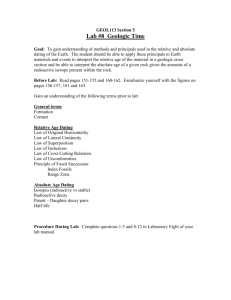


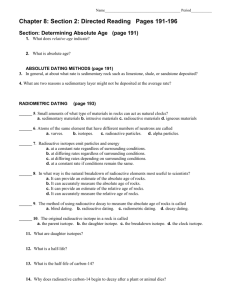


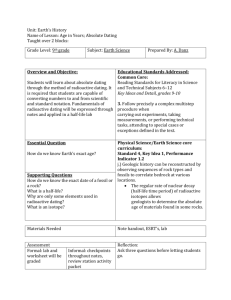

![tutorial #14 [nuclear physics and radioactivity] .quiz](http://s3.studylib.net/store/data/008407305_1-1884988a9e5162a6b7a2b0d0cf8c83c5-300x300.png)
